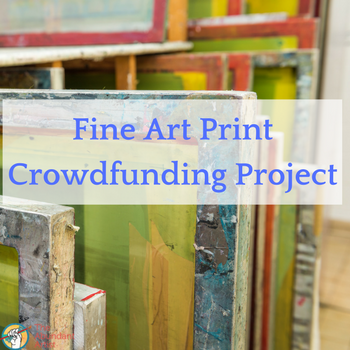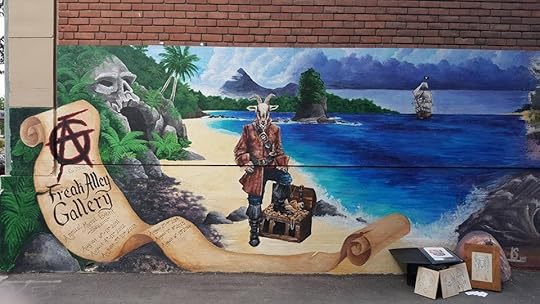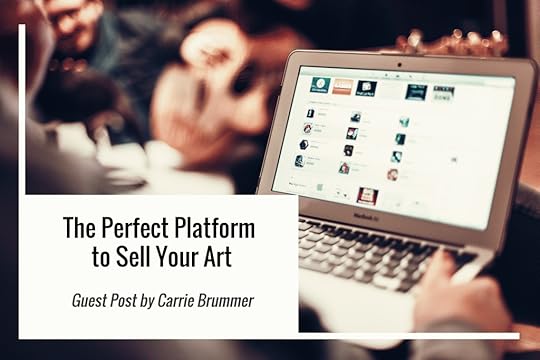Cory Huff's Blog: The Abundant Artist Goodreads blog, page 28
April 4, 2017
ConvertKit Review: Simple Email Marketing for Artists
Last year, I did an hour long interview with Nathan Barry, founder of ConvertKit*, a simple email marketing service that was designed for bloggers. The video above is a recording of that interview. We touch on the broad strategies of email marketing, what ConvertKit is good at, and some other fun stuff.
A lot of artists have asked TAA if ConvertKit* is a good email marketing option for artists. Here’s my take on it after having been a user for about a year.
Is ConvertKit Good for Artists?
When artists do email marketing, they need their email service to be easy to use, they need to be able to insert images of their art, and it needs to be flexible enough to grow with their business.
Does ConvertKit do this? I’ll quote Melissa Kojima here.
“Pluses:
+ Having everything triggered as soon as someone signs up
+ Scheduling newsletters weeks in advance
+ Getting stats
+ Taking notes on each subscriber
+Have sequences triggered after 1 sequence is finished, etc. (note from Cory – we cover this in HTSYAO 201: Sales Funnels for Artists)
+ Good customer service
+ Tagging to segment different subscribers
Minuses:
-Not being completely compatible with my Squarespace website. For example, I wanted to put a sign to form on a cover page, but it wasn’t compatible with that kind of Squarespace page. (from Cory: another client reports having a similar problem with Shopify – we’ve reached out to ConvertKit to see if they have a solve for this)
-Breaking the scheduling button and no one knowing how to solve it. I just ended up doing a hack and got it to work, but this was only after weeks of it not working.
-Not being automatically notified if there is a new subscriber unless you get another service from an affiliate website.
-Wanting more customization of the way the sign n forms look. It’s pretty limited.
Overall:
I think it mainly works for what I want now, but I may want to change it later as my business grows and I want to do more complex things.”
Thanks for the response Melissa.
Our experience closely reflects Melissa’s experience with ConvertKit. It’s designed to be a lightweight system that makes email marketing easy.
In fact, we designed our email marketing example sequence from How to Sell Your Art Online 201 exactly around the way that ConvertKit encourages you to create your first email sequence. For more email marketing templates and examples, see this post.
ConvertKit vs. Mailchimp
For a long time, TAA recommended Mailchimp as the best option for email marketing. We switched our recommendation to ConvertKit some time ago because ConvertKit’s segmentation functionality is better than Mailchimp. MC’s groups function is good, but it doesn’t have the same flexibility that ConvertKit has. Most major email systems use tagging systems because it allows you to be highly creative with how you suppress emails to certain groups or select a group of people to send emails.
Beyond that, Mailchimp and ConvertKit have similar pricing. Although MC does have a free account for small lists of under 2,000, you don’t get the automation features that make email marketing effective.
If you want to check out ConvertKit, click here to sign up*.
Have you used ConvertKit? Let us know what you think in the comments.
* = affiliate link
The post ConvertKit Review: Simple Email Marketing for Artists appeared first on Online Marketing for Artists.
You don’t have a hard work and hustle problem
Artists are probably some of the least-lazy people I’ve ever met. Making art, holding down a day job, managing a family, and trying to sell your art takes some hard work.
Lots of artists are hustling hard. Jamie, one artist I know, had been hustling especially hard. She had been making sales, but not at the level she wanted to be making.
Perhaps you’re in the same situation.
You’ve got a completely unpredictable art business – and you’re sick and tired of inconsistent sales.
You have long, agonizing dry spells, where you don’t sell anything at all….
Then you have periods when you’re hustling and filling tons of orders, because you have a good sales process in place and know how to tell your story, but you are not great at generating enough attention and traffic.
You get noticed and get some attention, but within a month or two that publicity dies down, and you’re back where you started.
You know your art is great, and receive regular praise from your peers, and from buyers – but you’re not sure how to translate that excitement and praise into a steady, consistent art business.
You’re trying to market yourself using social media, but you’re not getting sales from it. You’re liking, commenting, following and sharing, but you’re not bringing in traffic to your website, and no one is buying. You don’t understand how other artists are attracting thousands of followers, and why their followers are turning into sales.
You might have a small mailing list of subscribers who have signed up with you over the years, but you feel like your list is just too small…or perhaps you haven’t done anything to grow your list at all.
You feel like you could tell a great story and get lots of sales if only you could get in front of the right audience. Maybe you’ve got a day job that you’d love to quit, but your sales aren’t consistent enough for you to make the leap….or if you are already running your art business full time, you feel like you’re spinning your wheels when it comes to marketing.
….all this results in stress, overwhelm, fatigue, and money problems. You’ve got a business that is stressful, impossible to predict, and nerve-wracking – and you’re wondering where the JOY in your art business has gone.
IT’S NOT ABOUT HUSTLING HARDER
The key is creating a regular process for partnering with other people to get in front of their audiences!
Social media is great, but your tiny number of followers is never going to grow as fast as you’d like it to grow when you’re still trying reach people one on one. Here’s a dirty secret about Instagram celebrities: they didn’t accumulate 75,000 followers by commenting, liking, and sharing. They leveraged media.
So give yourself a break – and work on reaching out to others to partner on promotions.
How to Sell Your Art Online 301 is all about building that partnership promotion process.
We start April 17. Want to join us?
Click here: https://theabundantartist.com/htsyao301/
The post You don’t have a hard work and hustle problem appeared first on Online Marketing for Artists.
March 29, 2017
What happened when we did a 5 day media challenge
Last week we did a 5 day challenge to see how many artists could land some press coverage.
We laid out the following steps:
– identify your top 10 media outlets
– identify and follow the journalists from those outlets, see what they talk about
– write a press release
– send the press release
– reach out to at least two influencers to ask them to share your art
So what happened?
Dorothea discovered her art niche – recycled and upcycled art. As a beginner, she didn’t know this was an established art genre. So figuring out how to pitch her work helped her understand that there is an established audience for what she does.
She wrote a blog post about this discovery here.
Jessica immediately found a writer for a local magazine interested in doing a story about her.
Karen discovered an easy win – her university alumni website had an easy submission process to publish stories about her art.
All in all, hundreds of artists assembled lists of blogs, newspapers, magazines and other outlets to pitch their art, and many of them managed to get their first couple of pitches out last week.
And this is just the beginning.
Landing media coverage for your art is not nearly as hard as so many people make it out to be. We’ve helped a lot of artists do it already.
We are opening enrollment for How to Sell Your Art Online 301: Leveraging Other People’s People.
Essentially, we are breaking down the five steps we outlined above into four action-packed lessons. There’s no theory here – we show you what to do, what has worked for other artists, and how to do it.
The course starts April 17. Spots are limited. We will fill up quickly.
See you in class!
The post What happened when we did a 5 day media challenge appeared first on Online Marketing for Artists.
March 11, 2017
Call for Artists: TAA’s Fantastical Worlds, a Crowdfunded Fine Art Print Run
Based on last week’s poll, the winning theme for TAA’s crowd funded fine art print campaign is Fantastical Worlds.
FANTASTICAL WORLDS: From majestic depictions of imaginary realms to inventive works of abstraction, expressionism, and surrealism, we seek works that put a fantastical spin on the world around us.
We’re ready for artist submissions! You can click here to fill out our submission form. More information below.
This is a totally different kind of project from anything we’ve done before. It’s going to be a lot of fun. We are going to need your participation in order to make it happen.

Here’s the basic plan: source a bunch of great artwork from readers like you, curate a digital exhibition, and then run a crowdfunding campaign to turn the work into a limited-edition run of fine art prints. We’ll use the whole experience to build out a best-practice crowdfunding guide for our community — and we’ll raise a bunch of funds for artists in the process. Read on to get involved!

The first step for us is to pick the theme of the digital exhibition.
To that end, TAA will be working with curator and digital strategist Willa Koerner. She’ll be helping us to choose artworks for the campaign that will be, 1) compelling to potential backers, and 2) artistically interesting and relevant.
Willa currently directs curation at Kickstarter, and in the past she worked at the San Francisco Museum of Modern Art. She has also worked on digital engagement and creative campaigns for organizations like the Smithsonian and ART21. She was on our podcast back in September (listen here).
More Details
This is a big project, and we want to do it right. It has to fit in around the other projects and business needs that TAA operates under. So we’re sharing everything we have so far, and more details will be forthcoming as time goes along.
Why are we doing a crowd funded print campaign?
First of all, it totally aligns with TAA’s goal of helping artists quit their day jobs. It’s a shift away from courses and coaching, but will also help us build out a crowdfunding course for artists.
In addition to being an interesting and fun project, it lays the groundwork for helping TAA launch an artist cooperative online gallery. Last week I did a short Facebook Live broadcast about what we’re doing. Here’s the video:
We’re picking 5 – 10 artists to feature in a run of fine art prints. Artists are free to submit from anywhere in the world.
We will be using Kickstarter.com to fund the project partially because Kickstarter has the largest crowdfunding audience in the world.
We will be documenting every step along the way. Including:
How we decide which artists to pick
How we decide which printer to use – both from an economic perspective, but also taking into account issues like sustainability, respecting the artist’s work
The artist’s work in process – how the artist created the art, what the process looked like (both in pictures and in video), as well as how the prints are made
In addition, we will be having each artist participate in the marketing for the campaign. The TAA team will help create the strategy for the marketing, and support the artists through the process. Each artist will be responsible for some specific part of the marketing campaign, as this is as much an education process for them as it is a money making venture.
Tasks individual artists who are chosen for this project might perform include:
direct media outreach to get coverage for the project
direct outreach to influencers who would be interested in the kind of art the artist produces and/or in supporting the project in general
sharing the campaign with their own audiences via social media, email, and other channels
Phases
Find the artists & prepare the print series – March – April (Submissions due April 9)
Prepare crowdfunding campaign – April – May
30 day launch mode – July
Document delivery – August & September
Analyze results – October
We will be creating more blog posts on each of these phases to keep everyone up to date. The goal for this project is total transparency, so you can see what it takes to get one of these campaigns up and running!
To close, yes, TAA is taking a small financial percentage of sales, but only if we raise enough to make the project work – we don’t get paid unless the artists get paid – and it will be a smaller percentage than most galleries take. We haven’t settled on a final amount yet, but will definitely be less than 30% of sales. The artists will keep at least 70% of the profit, after operational costs for printers, shipping, etc.
So if you’re still interested after all of that, apply here.
The post Call for Artists: TAA’s Fantastical Worlds, a Crowdfunded Fine Art Print Run appeared first on Online Marketing for Artists.
March 6, 2017
Help us Pick the Theme for Our Print Crowdfunding Project
This is a totally different kind of project from anything we’ve done before. It’s going to be a lot of fun. We are going to need your participation in order to make it happen.
Here’s the basic plan: source a bunch of great artwork from readers like you, curate a digital exhibition, and then run a crowdfunding campaign to turn the work into a limited-edition run of fine art prints. We’ll use the whole experience to build out a best-practice crowdfunding guide for our community — and we’ll raise a bunch of funds for artists in the process. Read on to get involved!
 The first step for us is to pick the theme of the digital exhibition. To that end, TAA will be working with curator and digital strategist Willa Koerner. She’ll be helping us to choose artworks for the campaign that will be, 1) compelling to potential backers, and 2) artistically interesting and relevant.
The first step for us is to pick the theme of the digital exhibition. To that end, TAA will be working with curator and digital strategist Willa Koerner. She’ll be helping us to choose artworks for the campaign that will be, 1) compelling to potential backers, and 2) artistically interesting and relevant.
Willa currently directs curation at Kickstarter, and in the past she worked at the San Francisco Museum of Modern Art. She has also worked on digital engagement and creative campaigns for organizations like the Smithsonian and ART21. She was on our podcast back in September (listen here).
Willa and I have had conversations about this, and here are some of the theme ideas we are interested in. You can vote on them in this embedded poll. (note that if the embedded poll doesn’t work, you can also visit the poll here)
Loading…
Once we’ve selected a theme for the print series, we will move on to the next phase of the project.
More Details
This is a big project, and we want to do it right. It has to fit in around the other projects and business needs that TAA operates under. So we’re sharing everything we have so far, and more details will be forthcoming as time goes along.
Why are we doing this?
First of all, it totally aligns with TAA’s goal of helping artists quit their day jobs. It’s a shift away from courses and coaching, but will also help us build out a crowdfunding course for artists.
In addition to being an interesting and fun project, it lays the groundwork for helping TAA launch an artist cooperative online gallery. More on that vision in a later blog post.
Phases
Find the artists & prepare the print series – February & March
Prepare crowdfunding campaign – April/May
30 day launch mode – July
Document delivery – August & September
Analyze results – October
Each of the above phases will be detailed in later blog posts, but for now, we need to pick a curatorial vision for the project. Let us know which of the themes you like by voting on the poll above.
The post Help us Pick the Theme for Our Print Crowdfunding Project appeared first on Online Marketing for Artists.
March 2, 2017
Do Less. Earn More.
What if I told you that the key to selling more art is to do less?
Would you be upset, or would it free you up?
I had a really interesting experience with two back to back coaching calls today.
One artist is doing a TON of different things. She’s selling original pieces, and prints of those pieces. She’s also selling another line of art in a slightly different style. She has sold art to celebrities.
On top of that, she has two print licensing deals. She’s been featured in Target and on a famous TV show. She won a juried art show that brought her a lot of prestige.
Her business is complex, and busy.
And she’s not making enough money to get by.
She’s thinking about taking on a part time job to make ends meet.
Earlier in the day, I had another call with an artist who only does one thing. He paints a specific group of animals in a very specific style, and he does all of his marketing through two large websites.
He’s making a handsome income, living in California. He owns his house and his monthly income is predictable.
We are working together to introduce a new series of work. He has the resources from his previous sales to make a go at selling this new work in a major way.
It’s his first new series in several years. He’s focused and disciplined. He doesn’t do licensing or commission work. He paints and sells the originals and prints of those paintings to his core audience.
By doing less and keeping your business model simple, you can concentrate on serving one audience with a simple line of art that resonates with that audience. You can make a great living when you keep things simple.
That doesn’t mean you can’t make other art in your own studio time.
But keeping your business simple means you can make more money.
Just a thought.
The post Do Less. Earn More. appeared first on Online Marketing for Artists.
February 14, 2017
How to Build Up Your Artist Cred and Become a Kicka$$ Commission Artist
By Katie Kapro
 Freak Alley Pirate Goat, 2016 courtesy of Screamer Illustration & Mindy Field
Freak Alley Pirate Goat, 2016 courtesy of Screamer Illustration & Mindy FieldMaking the transition from a free-time artist to a full-time commission artist is not an endeavor for the weak of spirit. It takes a lot of creative energy and at least one day-job to pay the bills. It also requires some seriously honed social skills — yes, even the most socially awkward of artists find a way to make their awkwardness work to their benefit.
Here is a treasure trove of lived advice from two of my favorite local artists who have found a way to bring art into their daily lives, and even make a little money while they’re at it.
Be in the World
While you’re toiling away in your studio with oil paints and Photoshop, don’t forget to emerge every once in awhile to participate in the wider art community. Being immersed in the creative process is, of course, the most important part of creating art, but the only way to get your art out there, and someday get paid for it, is to jump into the pond with all the other artists in your community.
Taking part in local art initiatives is a fun way to make friends, aka “networking connections,” and gain exposure in the art scene.
In my town, one of the most popular places for new and seasoned artists to share their work is an outdoor gallery called Freak Alley. Once a year, artists pitch the gallery owners with their mural ideas and around 40 artists are selected to repaint the walls of the alleyway.
Not only do artists get to share their work with the public, but it has also proven to be an entry point for paid design gigs with local businesses.
Be a Pillar
Once you’ve figured out the vibe of the art community in your city, town, or neighborhood, try stepping into it in a big way. Attend creative gatherings and gallery openings. Make yourself known.
If the local vibe you find doesn’t fit your aesthetic, find a niche and build up your own community of artists. Keep in mind that it’s usually a good idea to have a positive relationship with the wider artistic community no matter what differences may present themselves. The more avenues you have for referrals, the better your chances of making it as a working artist.
Building up one’s own creative community can take all sorts of forms.
Extroverted artistic types might consider organizing a public event like an art show or artist discussion series as a way to share the work of emerging artists, support community, and build up their experience in the art world. As a bonus, organizational skills are a major plus to any prospective client.
As you’re creating the promotional materials for your event, remember that all materials you create are an opportunity to showcase your artistic skills. This, of course, works to an artist’s strengths; event promotion experts even suggest relying on images to do most of the talking. Easy peasy.
Hosting and organizing an event is good practice for any artist who wants to strengthen the connective tissue between the creative and analytical parts of their brain. Being masterful at balancing these aspects of the creative process is what makes for a really successful working artist.
For people who aren’t interested in taking on a public event, even hosting a weekly artist get-together in your home or studio is a great way to bring friends and colleagues into a regular rhythm of creativity. It’s networking, inspiration, and growing your artist community all in one. And let’s be honest, if you’ve got people coming to your space for artistic motivation, it’s a lot harder to procrastinate your own work.
Mind the Card
Business cards are an invaluable tool for any emerging creative freelancer. Some artists and designers feel uncomfortable handing out business cards, but remember, you’re not peddling anything. You’re handing someone a reminder that you’re available to help them out when the need arises. It doesn’t have to feel sleazy.
Having a business card you’re proud of is another aspect of natural and fruitful networking. Design a business card that speaks to who you are as an artist.
Appropriate timing and confidence also go a long way in the business card game. The time to offer a business card is not right when you meet someone; rather, talk for a while and get a feel for what kind of design they’re looking for. You’ll annihilate that awkward self-promotional feeling simply by having the confidence that your work really would be of benefit.
Equip Yourself
Another matter of business. When you’re out there displaying your work in public art spaces, make sure you’re equipped to handle the possibility that someone will want to give you money for your work. Whoa, I know. The door to a paid artistic opportunity can come in all shapes and sizes.
To be on par with the professionals, get a portable card reader so you can swipe a credit card right on your smartphone. It beats that awkward conversation about how you can take cash but you probably shouldn’t take a check because of all the fraud that’s been going around, and then you lose the sale because you basically called your potential buyer an identity thief. (True story.)
Or you can just plug a cute little reader into your mobile, get your art out there in the world, and get paid.
In addition to in-person sales, read-up on selling your work online. While it lacks the personal interaction that can so benefit an up-and-coming artist, it’s an unparalleled way to get your work out there.
Live Creatively
Most artists have this one covered but it’s worth mentioning nonetheless.
Make sure that your home or studio space — wherever you work and meet with prospective clients — sets the stage for your creativity. Even the most utilitarian elements of a studio space can be fodder for inspired design. The idea is to let your visual creativity spill over into your workspace.
Not even the bookshelves will be safe from your artistic awesomeness.
In addition to all that, just because you might be hosting potential clients doesn’t mean your studio or workspace needs to be office-like. The professional presentation of one’s creative space is given a little more freeform in this modern era of freelancing. Just be sure that your workspace looks intentional (i.e. not a pig sty) for visitors.
From designing a workspace to carving out a place in the greater artist community, the work of a burgeoning commission artist is expansive. Being in a supportive community and having the right tools with help any new designer set off on the right foot.
What are your favorite community art endeavors? And how have they influenced your creative career?
Author Bio: Katie Kapro holds an MFA in nonfiction writing. She covers design, education, and culture. When not writing, she can likely be found running in a herd of pygmy goats, giggling like a little girl. Follow her on Facebook and Twitter @kapro101
The post How to Build Up Your Artist Cred and Become a Kicka$$ Commission Artist appeared first on Online Marketing for Artists.
February 8, 2017
How many people do you need on your mailing list?
Kris Baum, on our Facebook page, left the following comment when I asked what everyone’s biggest questions about email marketing are, “What are the metrics…how many leads need to be generated to make sales? whats the ratio of $$ spent getting those leads to $$ for an average sale from those leads?”
This is a REALLY SMART QUESTION. It gets to the heart of what email marketing is all about – lead generation, and converting leads into sales opportunities.
Here was my answer to her:
Funnel structure:
Awareness – 1000 people have seen your stuff on social media or elsewhere
Leads – 100 people specifically on your mailing list
Opportunities – 10 people making sales inquiries (or adding to their ecommerce cart)
Sales – 1
You can work out the money spent at each stage by looking at what your final sale is worth. Kris jumped on this right away.
In Kris’ words, “Essentially if you sell your art for a net profit of $1000 per piece it is $1 made for every person seeing your stuff.”
Yup.
And then Dana Batho added, “And it means if you’re spending less than $1 per person seeing your stuff, you’re coming out ahead.”
This exchange goes right to the heart of how marketing works.
Obviously the numbers above are arbitrary. If you got your art in front of 1,000 of your ideal collectors, your leads, opportunities, and sales would all increase.
One more math example.
What is the right percentage of people who visit my website that I should expect to join my mailing list?
Typically, that percentage is less than 5%. So if you get 100 people on your website, less than 5 will join your list. That’s if you’re doing all of the right things – you have an opt-in gift, a clear value proposition for the list, and its easy to join the list.
So you have to know if you have enough visitors on your website. This number is usually referred to as Unique Visitors or Unique Visits in your analytics tools.
The point is that most artists simply aren’t doing enough marketing to make the numbers move. The above numbers are general numbers for most professional marketers, like me.
Takeaway: if you are getting less than a few hundred visitors to your website per month, you need to work on getting more traffic. If you have significantly more traffic than a few hundred visitors per month, then you don’t need more traffic, you need to work on converting your list into sales.
(note that this formula is totally different if you’re spending money on driving traffic with ads, but that’s a discussion for another time)
If you want to join next week’s email challenge, click here.
In our next post, I’m going to address some of the questions that so many artists like you sent me before. The subject line will have something like, “Email Marketing: Your FAQ Answered.” Watch for it.
The post How many people do you need on your mailing list? appeared first on Online Marketing for Artists.
January 31, 2017
5 Steps to Better Email Marketing for Artists
Yesterday I did a short Facebook Live broadcast where I talked about 5 steps to making better email marketing for your art. Here’s the short video.
Here are the five steps I outlined:
Know your story
Invite collectors on a journey, just like when you are explaining your journey in person
Tell stories in your emails
Ask for the sale
Activate your people
It’s a short little video where I talk about what each of those things mean, and then I introduced the TAA Email Marketing Challenge.
 In the challenge, you will receive one email each day for five days with a single action you can take to:
In the challenge, you will receive one email each day for five days with a single action you can take to:
Stop wasting time with email newsletters and learn no-spam, effective email marketing that produces sales
Bond with enthusiastic fans and collectors by sending them inside looks into your studio that make them feel special
Daily emails with quick actions.
No long instructions. Just a few quick thoughts each day to keep you moving forward.
The post 5 Steps to Better Email Marketing for Artists appeared first on Online Marketing for Artists.
January 16, 2017
What is the Perfect Platform to Sell Your Art?

Today there are countless resources for artists seeking to develop an online presence to promote the sale of their art. Should I sell my art on Etsy? What about Shopify? Fine Art America? Saatchi? What about my own website? So, how do we possibly choose?
I have tough love for you today. Are you ready? The truth: it doesn’t matter which platform you use. In fact, many of you use this question and the endless research you do to avoid a much greater fear: what if I can’t sell my art?
I am part of several business based online art groups. In one, someone shared the frustration that despite two attempts of creating a storefront, she had zero sales. It got me thinking: how much responsibility do we place on our platform for our sales? And I’ve realized, myself included, too much. Because our platforms don’t generate sales: we do.
I know what it means to be an endless researcher: I am one. Which email provider should I use? How should I host my tutorials? Where should I post and sell my art? I wish had known the answer earlier: experiment. Pick one. Try it out. Stick with it. After a while you may decide it’s clunky, or that you need a better check out process. Then guess what? You can try another. The important thing is to get started and choose one. Because here is another truth:
We worry about the platform because we want to be “found.” The artist myth of being discovered has extended to the internet.
Do you know how most artists are “found?” By doing a whole lot of work! They promote their art, they make partnerships with the right people, and they spend time engaging with potential collectors. Artists who sell are doing this while the rest of us jump around from platform to platform because we “just aren’t getting any sales.”
There are, of course, considerations we should factor in when choosing a platform and here are some of them:
How much money are you willing to invest?
Having someone build your website, or knowing the monthly fees from something like a Shopify store are important to note. If you want to bootstrap your growth, using payment systems/platforms like Gumroad, Stripe, or Etsy can save you a bit of money.
Can you build your own website?
If you can, and it’s not going to take you forever and a day to set this up, owning your web property is the best way to go. But this means knowing how to set up shop carts, checkout systems, as well as how to best display your art. Are you willing to learn all of this and take that time from your art?
What’s easiest for you to get started?
A lot of artists give up because after doing all the research (and you can spend months on it, I know) you are tired, overwhelmed, and still without an online artist shop. What can you do that will get you set up and started in one day? In one week? Be practical and honest with yourself. What kind of time commitment is actually sustainable for you?
What’s easiest for your collectors?
Artists often forget this key point: we are serving potential and current collectors. Our job is to make them happy. This includes buying and checkout experience, how you ship and package your art, and how you follow up with them after the purchase is made. What systems will be less confusing and easier for them to use?
Can you collect customer emails?
You want to have access to the email address of collectors to reach out again and offer them more value to create repeat collectors. What system easily pairs up with your email provider? Mailchimp has a free mail provider offering. Or, you could use something like Patreon that builds in communication with crowdfunding commitments. I use Convertkit and like it, but see above: How much money are you willing to invest?
Does your branding match well with your platform?
Can you alter the platform or use it in a way that complements the style of art you create? Branding is a one way to build trust and authority so collectors trust you enough to buy art from a “stranger” online. However, don’t let this stop you from setting up a shop. This is a factor to consider later on when you are making a regular income. It’s more important to set up a shop!
Using these questions ask yourself: what feels easy and good to you? Start small and build. If you know nothing about building websites, choose a platform that can act as a portfolio space for you. Of, if money is a concern, which platform requires the least amount of upfront investment?
You are not permanently committed to any platform you choose. Just as our art evolves, so can our platform, so can our entire online presence! As your income increases and you work with your collectors, the factors that influence you will ebb and flow in priority. Too many artists switch too soon because they are concerned about being “visible.” Know what would garner greater visibility? Making and sharing more art.
That hope and dream of being discovered can cloud our judgment when it comes to questions like this one. Choosing a platform isn’t about being found. And if that’s your focus it’s time to change your priority: focus on your past, current and potential future clients: how can you best serve them?
Platforms promote themselves based on this discovery myth but they don’t promote your art. Neither does social media, nor your website, nor your blog. They don’t promote your art: YOU do. And not a single platform can change that.
BIO:
Carrie Brummer is an artist, educator and entrepreneur all wrapped into someone who loves traveling, eats way too much dark chocolate and just recently moved to Canada from Muscat, Oman.
Carrie believes engaging with our creative interests makes us happier, healthier, more fulfilled human beings. She created her community www.ArtistStrong.com to help everyone honor their desire to be creative. Cultivate your creativity by joining her free 10-day art challenge www.SoulbrushSessions.com.
The post What is the Perfect Platform to Sell Your Art? appeared first on Online Marketing for Artists.
The Abundant Artist Goodreads blog
- Cory Huff's profile
- 31 followers




